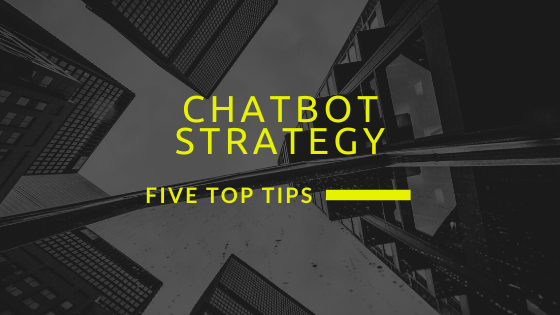Here are five key tips for coming up with a great chatbot strategy for your organization!
“For companies that are just beginning the bot journey, the critical first step is to develop a bot strategy.” –
Accenture Digital report ‘Chatbots Are Here to Stay’.
Congratulations on having made the important decision to include chat marketing in your digital strategy. Or perhaps you’re just thinking about it, the pro’s and cons, the ins and outs, and need to find out more about how exactly to incorporate this super-exciting and very worthwhile tool into your business and marketing strategies.
Either way, here’s the low-down on how to develop a great chatbot strategy, whatever your sector or organization size, with five top tips …
1. Make Sure Your Chatbot Strategy Fits Your Business Objectives
No right-minded business would ever invest in any technology without properly understanding its value to the business, and chatbots are no exception.
AI is often presented as some sort of silver bullet for businesses, but it pays to be clear from the very start around what you’re hoping to achieve by employing bots.
Clearly define the business goals you’re aiming to achieve here. Chatbots are beautifully placed to enhance customer experiences and efficiency in the same breath, but you need to be really clear in your own mind how chat marketing will be at the service of your organization’s goals (and not the other way around).
Define the business goals you’re aiming to achieve with chatbots.
This is, after all, a long-term investment that needs to be justified and which will need to evolve as the organization organically evolves.
Aligning chatbot strategy with your business objectives is your starting point.
2. Is Your Infrastructure Bot-Ready?
As it happens, corporate technology in recent times has really shifted to enable flexibility, with companies having seen that rapid change is inevitable and that being able to adapt to the smartest new technologies that customers love is now the name of the game.
Equally, the way customers use bots is an unfolding experience too. Because of this, built-in flexibility to accommodate different platforms and devices – including ones that may not yet exist! – is essential.
:
“The manner in which your business uses a chatbot will be limited only by your own creativity” – .
Inbenta
Other elements of your bot-ready checklist could include:
Humans!
It’s still humans that input chatbots’ knowledge base, and ‘blended’ communications, when humans are needed to step in because bots might not be confident about their answers 100% of the time, will be with us for some time yet. In fact, for the foreseeable future we should all regard the world of chatbots as an area of really progressive human-AI collaboration.
Information
The type of information held by your organization that will be super-useful for chatbot work includes customer account histories, product specifications and many other types of key data. Much of this will currently be stored in different systems and platforms, but it needs to be mobilized if you’re to offer fully optimized customer service via chatbots.
Security
Chatbots will be handling potentially sensitive customer data, so you need to ensure all the appropriate boxes are ticked in this respect.
In short, chatbots should be connected as seamlessly as possible with your entire business eco-system!
“Bots should be how executives demonstrate the value of the AI systems they have in place” –
P.V. Kannan, CEO and Co-Founder, [24]7.ai.
3. Balance Investment and RoI

Chatbots are key to delivering great customer experience and to enhancing customer relationships with your brand – but those things can be pretty difficult to quantify.
‘Where’s the RoI?’, your colleagues and board members will ask, so be ready to answer it deftly!
Image: speech balloon saying Where’s the RoI?
Make a fully-costed argument around cost savings and improved revenue. This will be a straightforward exercise – but it’s important not to overlook it. The customer experience benefits of chatbots are so obvious, it’s surprisingly easy to neglect to back your strategy up with properly crunched numbers.
Remember, too, that as far as chatbots are concerned, return on investment isn’t always immediate. Think long-term, because this is something that really helps cement your customers’ relationships with your brand, and the true yield can start to be evident after several financial quarters rather than in the first.
Boxed quote:
Return on investment isn’t always immediate with chatbots – we’re in the business of building customer relationships here.
4. Integrate Your Bot Strategy Across Devices
Image: a device (phone / tablet) or several devices
Make sure your chatbot is fully integrated across a wide range of customer devices, leveraging your organization’s current tech investments and extending them to as broad a customer audience as possible, using devices they have now as well as devices they’re likely to have in the near future.
Chatbots are by far the most efficient way of putting your organization’s knowledge base to work, and this needs to be made as easy as possible for your customers so they can find the answers or support they’re looking for, regardless of the device or channel they’re using.
Boxed quote:
Make sure your chatbot is fully integrated across a wide range of customer devices.
5. Communicate your Bot Strategy Effectively to the Board
Boxed quote with black and white image of George Bernard Shaw (and box the quote differently than all the business-related ones)
“The single biggest problem in communication is the illusion that it’s taken place” – George Bernard Shaw.
You’re going to need management and board buy-in for your bot strategy, so bear in mind the following points when broaching the issue with them …
Senior executives will want the full low-down
Your board members and management will surely be au fait with latest technology, even if only with a passing knowledge gleaned from current affairs.
But what’s even more certain is that where technology serves a dual function of improving business efficiency and giving customers or stakeholders what they want, it will be much more than a curiosity – it will be top of mind, so they’ll want the full low-down on exactly how chatbots can help the organization, and in what sort of time frame.
Be aware of barriers
At the same time, though, you need to be aware of the barriers that some senior managers may have around chatbots. Top of the list here, according to Accenture Digital research, is a fear that users would be reluctant to engage with a bot – but they may also be worried about privacy and security, regulations, skills required on the development side, and platform fragmentation among others.
Reasons Executives Give for their Companies Not Planning to Implement Bots
| Users may be reluctant to engage with chatbot | 64% |
| Sub-par integration for personalized experiences | 51% |
| Sub-par understanding of human input | 47% |
| Privacy / security / legal / regulatory worries | 45% |
| Shortage of skilled developers | 44% |
| Poor mechanisms for discoverability | 26% |
| Platform fragmentation | 20% |
[Source: Accenture Experience Orchestration as a Service Survey, 2017 –
Competitors count!
Senior managers will also want to know what competitors are doing in this area, so find out! And if competitors are being slow to harness the potential of chat marketing, be sure to be able to effectively communicate to your management colleagues how your organization can easily steal a brilliant march this way.
Demo it

It might be a good idea to schedule a live demo for board members – sometimes, people need to see the technology in action to understand its benefits. Seeing other businesses – including competitors! – employing chatbots effectively in real time can be a very persuasive exercise.
At Gabba we regularly schedule live demos talking all things chatbot strategy: harness these to help spread the word in your organisation!


